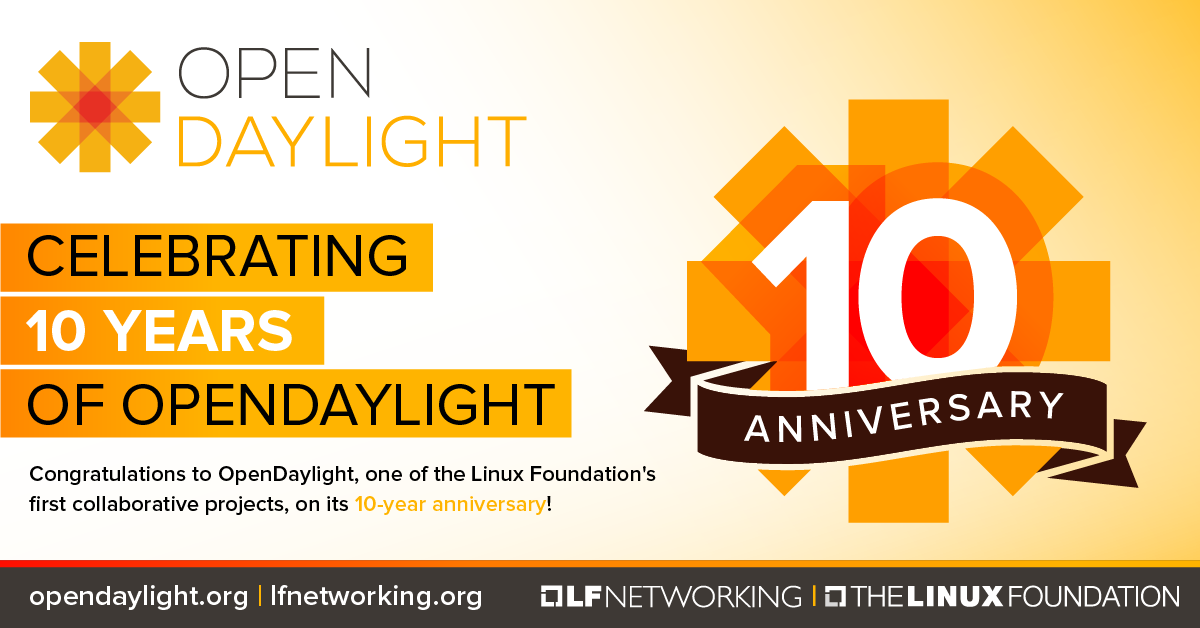OpenDaylight: Celebrating 10 Years of the Most Popular Open Source SDN Controller
The Linux Foundation | 22 August 2023
This year marks the 10-year anniversary of Open Daylight, so we at LF Networking wanted to spotlight how it has grown to be the most popular open source SDN controller, a top important open source project in networking, and how it will continue to evolve in the future.

The beginnings of SDN
OpenDaylight's story began in the world of software-defined networking (SDN), which started gaining momentum around a decade ago. Even though OpenDaylight did not start things, it played a key role in creating a critical mass for SDN technologies.
The project was launched under The Linux Foundation to focus on SDN and related technologies and quickly gathered a devoted community where meritocracy and contributions continue to matter above all to this day.
OpenDaylight emerged as an open source community and a meritocracy where contributions matter above all. It was launched under the Linux Foundation, focusing on SDN and anything related to it. The contributors were responsible for committing to their projects and fulfilling the deliverables without external intervention.
Initial Challenges and Evolution
Defining what SDN is and how it works in the early stages posed significant challenges. Different partial solutions, pieces of the puzzle, and individual use cases made SDN a complex yet promising realm.
One of the critical developments that helped solve these challenges was the evolution of YANG. Before YANG, configuration data lacked clear definitions. YANG tackled this problem, clearly defining configuration and its intent.
In 2012, two significant things happened that pushed SDN forward:
- OpenFlow 1.3 was introduced, allowing for OpenFlow to be used in production.
- The initial code drop of Cisco got incorporated into a Linux Foundation private repository, marking the beginning of OpenDaylight as a community aimed at covering every aspect of SDN.
Over time, various changes were made, especially in the areas of automation and documentation. The core focus was on building use cases and strengthening the developer community. Projects around BGP, PSAP, and others were introduced, enabling integration within service provider (NSP) networks.
However, migration to Apache Karaf 4 revealed significant technical debt that needed to be handled. This meant OpenDaylight needed more refinement and redefinition of its scope which would eventually stabilize it.
What’s in store for the future?
As it stands, OpenDaylight is at the forefront of network programmability and automation. Its scalability improvements, in particular, have had significant impacts since 2015. The years ahead will continue this trend as they strive to enhance the project's scalability further and flush out remaining legacy code. However, a potentially painful revision is coming up that will aim to remove all compatibility layers, even though they're not causing any pressing issues. This suggests an ambition to ensure OpenDaylight remains streamlined, modern, and free of unnecessary burdens that could affect performance or compatibility with emerging technologies.
Moreover, OpenDaylight aims to transition to a more microservices oriented architecture, which is a significant shift in its design philosophy. A microservices-based architecture, often used in conjunction with containerization technologies like Docker and orchestration platforms like Kubernetes, will enable OpenDaylight to be even more modular and scalable. This architectural shift will make contributing to OpenDaylight much more manageable, especially for bug fixes, given the decoupling of services in such a setup.
While the path ahead isn't without its own challenges, OpenDaylight's past decade shows a project that isn't afraid to adapt and change, a quality that will be essential in the coming years; OpenDaylight's continued relevance will depend on its ability to adapt and innovate, something that the OpenDaylight community seems more than prepared to do. So, while the future is uncertain, one thing is clear - OpenDaylight is more than ready to face whatever lies ahead, forging a path forward in the world of open-source SDN solutions.
The future for OpenDaylight is looking both exciting and challenging. Given the complexities and changing nature of network environments, the continued relevance of OpenDaylight hinges on its ability to evolve and adapt to new industry trends and standards.
About OpenDaylight
OpenDaylight (ODL) is a modular open platform for customizing and automating networks of any size and scale. To learn more about OpenDaylight including how to contribute to the project, please visit OpenDaylight.com and subscribe to the newsletter.
About Linux Foundation Networking
To learn more about open source networking projects under the LF Networking umbrella, please visit the LF Networking website. Follow us on LinkedIn (LFNetworking LinkedIn and ONE Summit by LFN LinkedIn) and Twitter so you don’t miss out on what’s happening in the world of open source networking. Bookmark our YouTube channel to watch all recorded sessions from LF Networking events.